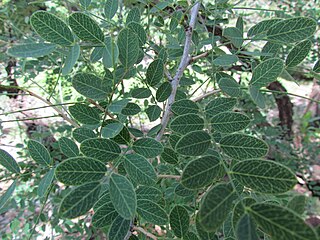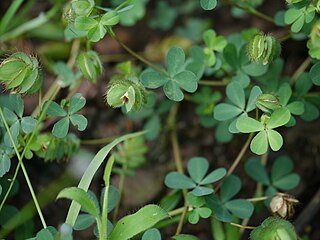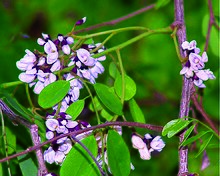
The Faboideae are a subfamily of the flowering plant family Fabaceae or Leguminosae. An acceptable alternative name for the subfamily is Papilionoideae, or Papilionaceae when this group of plants is treated as a family.

Zornia is a cosmopolitan genus of herbs from the legume family Fabaceae. It was recently assigned to the informal monophyletic Adesmia clade of the Dalbergieae.

Acosmium is a South America genus of flowering plants in the family Fabaceae. Three species are currently recognized. Most Acosmium species have been recently transferred to Leptolobium and one species to the South American Guianodendron while the genus Acosmium itself has been transferred from the tribe Sophoreae to the tribe Dalbergieae in a monophyletic clade informally known as the Pterocarpus clade.

Geoffroea is a rather small genus of wild spiny shrubs or small trees of tropical and subtropical South America. Although it gathers few species, they are highly extended geographically throughout the subcontinent. Each species is well known in its local area, as seen from the varied usage of these trees as food, timber, or fuel. It was recently assigned to the informal monophyletic Pterocarpus clade within the Dalbergieae.

Andira is a genus of flowering plants in the legume family, Fabaceae. It is distributed in the tropical Americas, except for A. inermis, which also occurs in Africa. It was formerly assigned to the tribe Dalbergieae, but molecular phylogenetic studies in 2012 and 2013 placed it in a unique clade within subfamily Faboideae named the Andira clade.
Ormocarpum is a genus of flowering plants in the legume family, Fabaceae. It includes 17 species native to tropical and southern Africa and parts of India, Indochina, Malesia, Papuasia, and the South Pacific. The genus was recently assigned to the informal monophyletic Dalbergia clade of the Dalbergieae.

Paramachaerium is a genus of flowering plants in the family Fabaceae native to Amazonia. It was recently assigned to the informal monophyletic Pterocarpus clade within the Dalbergieae.

Platymiscium is a genus of flowering plants in the family Fabaceae, and was recently assigned to the informal monophyletic Pterocarpus clade within the Dalbergieae. It has a Neotropical distribution, from northern Mexico to southern Brazil. Platymiscium is the only genus in the family with opposite leaves in all its species. Its wood has various uses, mostly for constructions and furniture. It's wood is also sometimes referred to as Granadillo, Macacauba, Macawood, Hormigo, or Orange Agate.
Bryaspis is a small genus of flowering plants in the legume family, Fabaceae. It includes two species of herbaceous plants native to equatorial West Africa and Cameroon. It belongs to the subfamily Faboideae, and was recently assigned to the informal monophyletic Dalbergia clade of the Dalbergieae. Typical habitats are seasonally dry tropical grassland and open areas, often growing in wet, swampy, rocky and sandy soil. Plants can be weeds on cultivated land.

Cranocarpus is a genus of flowering plants in the legume family, Fabaceae. It includes three species native to northern and eastern Brazil. It belongs to subfamily Faboideae, and was recently assigned to the informal monophyletic Pterocarpus clade of the Dalbergieae.

Diphysa is a genus of flowering plants in the legume family, Fabaceae. It belongs to the subfamily Faboideae, and was recently assigned to the informal monophyletic Dalbergia clade of the Dalbergieae. It includes 22 species which range from Arizona through Mexico and Central America to Colombia and Venezuela.
Fissicalyx fendleri is a species of flowering plant in the legume family, Fabaceae. It is a tree native to the tropical Americas, ranging from Panama through Colombia, Venezuela, and Guyana to northern Brazil. It grows in humid lowland forest.

Geissaspis is a genus of flowering plants in the family Fabaceae. It contains one accepted species, Geissaspis cristata. It is a scrambling annual or perennial that ranges from the Indian Subcontinent through Indochina to southern China and Peninsular Malaysia. It has three varieties:
Pictetia is a genus of about eight species of trees and shrubs in the family Fabaceae with spiny stems and spine-tipped leaflets. The genus is endemic to the Greater Antilles, but its closest relatives are in Mesoamerica and Africa.

The vataireoids are an early-branching monophyletic clade of the flowering plant subfamily Faboideae that are mostly found in northern South America, primarily Brazil.
Steinbachiella leptoclada is recently reinstated species of flowering plant in the legume family, Fabaceae. It is a tree endemic to Bolivia. It is the only member of the monotypic genus Steinbachiella. The genus is assigned to the informal monophyletic Dalbergia clade of the Dalbergieae.
Maraniona lavinii is a species of legume in the family Fabaceae, and was recently assigned to the informal monophyletic Pterocarpus clade of the Dalbergieae. It is endemic to the Marañón Valley in northern Peru. It is the only member of the genus Maraniona and is closely related to the genus Tipuana.
The Andira clade is a predominantly Neotropical, monophyletic clade of the flowering plant subfamily Faboideae. The members of this clade were formerly included in tribe Dalbergieae, but this placement was questioned due to differences in wood anatomy and fruit, seed, seedling, floral, and vegetative characters. Recent molecular phylogenetic evidence has shown that they belong to a unique evolutionary lineage. It is predicted to have diverged from the other legume lineages in the late Eocene).

The dalbergioids are an early-branching monophyletic clade of the flowering plant subfamily Faboideae or Papilionaceae. They are pantropical, particularly being found in the neotropics and sub-Saharan Africa. This clade is consistently resolved as monophyletic in molecular phylogenetic analyses. It is estimated to have arisen 55.3 ± 0.5 million years ago. A node-based definition for the dalbergioids is: "The least inclusive crown clade that contains Amorpha fruticosaL. 1753 and Dalbergia sissooRoxb. ex DC. 1825." Indehiscent pods may be a morphological synapomorphy for the clade.
Meso-Papilionoideae is a monophyletic clade of the flowering plant subfamily Faboideae that includes the majority of papilionoid legumes. This clade is consistently resolved in molecular phylogenies. It contains many agronomically important genera, including Arachis (peanut), Cicer (chickpea), Glycine (soybean), Medicago (alfalfa), Phaseolus, Trifolium (clover), Vicia (vetch), and Vigna.












